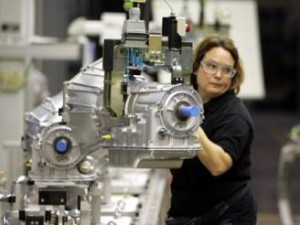Jack Metzgar: America’s Low-Wage Future

British historian E.H. Carr once said something to the effect that while no serious scholar makes up the facts, they all choose which facts “to put on stage.” The problem of cultural bias is that there are way too many facts to give them all their proper due, and in choosing what we think is most significant among them, we are guided by our own focus and general sense of significance – that is, by our values, our hopes and fears, and our everyday sense of how the world works.
[print_link]
Every two years the Bureau of Labor Statistics (BLS) makes detailed projections of how many jobs there will be in which occupations ten years from now. The latest onecame out late last year, and among a dizzying array of facts and figures, here’s what they headlined in italics at the top of their report:
Professional and related occupations and service occupations are expected to create more new jobs than all other occupational groups from 2008 to 2018; in addition, growth will be faster among occupations for which postsecondary education is the most significant form of education or training. . . . .
This was duly reported by The New York Times under the headline “Where the Jobs Will Be,” with the same emphasis on “professional and related occupations” and “postsecondary education.” The message is that our society is going to need many more college graduates than it has now, which is true. The impression most often left, however, is that we are rapidly becoming a society of “professionals” and “knowledge workers,” and that the key to our future is making sure that almost everybody gets a college education. This impression is not only false, but spectacularly so.
Disguised in the text, but present in the BLS tables is another set of facts: Only 21% of jobs now require a bachelor’s degree, and despite faster growth among these credentialed occupations, that isn’t going to change much. By 2018, according to the BLS, only 22% of jobs will require a bachelor’s degree or more. Of the 51 million “job openings due to [both] growth and replacement needs” in the next ten years, fewer than 12 million will require a bachelor’s degree.
 At the heart of what the BLS and The New York Times choose to put on stage is a confusion between the fastest growing jobs and the jobs with the largest job growth. Though the BLS tables report both the fast and the large in detail, the headline and the text emphasizes speed over size. For example, the fastest growing occupation in the next ten years will be biomedical engineers; these jobs will increase by a whopping 72% from 16,000 to nearly 28,000, a net increase of 12,000 jobs. Meanwhile, retail salespersons will see job growth of a meager 8.4%, but since there are now more than 4 million of them, that’s an increase of 375,000 jobs.
At the heart of what the BLS and The New York Times choose to put on stage is a confusion between the fastest growing jobs and the jobs with the largest job growth. Though the BLS tables report both the fast and the large in detail, the headline and the text emphasizes speed over size. For example, the fastest growing occupation in the next ten years will be biomedical engineers; these jobs will increase by a whopping 72% from 16,000 to nearly 28,000, a net increase of 12,000 jobs. Meanwhile, retail salespersons will see job growth of a meager 8.4%, but since there are now more than 4 million of them, that’s an increase of 375,000 jobs.
A second confusion involves the word “service,” which in other contexts is used to indicate all work that does not involve making or building things, as in “service economy.” This usage conjures images of doctors, lawyers, teachers, and management consultants – all of them growing occupations and highly paid. But that’s not what the BLS means by “service occupations.” The BLS service jobs with the largest projected growth are home health and personal aides; food service workers (including fast food); nursing aides; landscaping and groundskeeping workers; medical assistants; security guards, and child care workers – all of them already very large and all of them paying “low” or “very low” wages.
Of the 30 fastest growing occupations, 14 require at least a bachelor’s degree and another five will require an associate’s degree; all 19 of these fast-growing jobs pay “very high” or “high” wages by BLS standards. That is good news. But among the 30 with the largest growth, only seven require a bachelor’s and one more requires an associate’s. And, unlike the fast, of the top 30 for size, the majority of new jobs are either “low wage” or “very low wage.” Here’s my tabulation of the largest 30 by how well they pay:
Top 30 occupations with largest projected job growth, 2008-2018
|
2008 median annual earnings
by quartiles (# of occupations) |
# of new jobs projected |
% of top
30 jobs |
|
Very High:
1,771,100 |
24% |
|
|
High:
$32,390 to $51,530 (8) |
1,523,100 |
21% |
|
Low:
$21,590 to $32,380 (9) |
2,131,400 |
29% |
|
Very Low:
Less than $21,590 (6) |
1,899,400 |
26% |
These top 30 occupations account for about one half of the net new jobs the BLS projects, and other data show that the wage composition of these 30 is not unrepresentative of the job structure as a whole, now and in 2018. If these were the facts the BLS chose to put on stage, the headline might be: Majority of American workers projected to remain poorly paid and in need of a living wage.
We might then realize that we cannot close the widening gap between the earnings of high school graduates and college graduates simply by producing more college graduates. There simply are not and will not be enough jobs requiring a college education. With a different set of facts on stage, we would understand that we need to do something to increase the majority’s wages and incomes directly.
What’s more, as a nation we know how to do this because we’ve done it before, in the three decades after World War II. Though each has its limits, we need some combination of greater unionization, steadily improving minimum wage laws, and enhancements in the social wage, now called “work supports.” Democrats, for all their other faults, have committed to advancing on all three of these fronts, and in the last three years have advanced a little on each of them. College professors (called “postsecondary teachers” and #10 on the BLS largest list) could lend a hand simply by putting some of these “other” facts on our stages. The BLS largest list is a richly complex document that reveals contradictory tendencies in what some 150 million of us do and will do to earn a living. My arrangement of that list by educational requirements and pay simplifies it some by separating out those countertendencies. No facts are made up, but by reorganizing the stage, the same facts make a decidedly different impression.
Jack Metzgar is Emeritus Professor of Humanities and Social Justice at Roosevelt University, Chicago. This post originally appeared on Working-Class Perspectives, the blog of the Working Class Studies Association.
Filed under: Economy | Tagged: jobs, low-wage economy